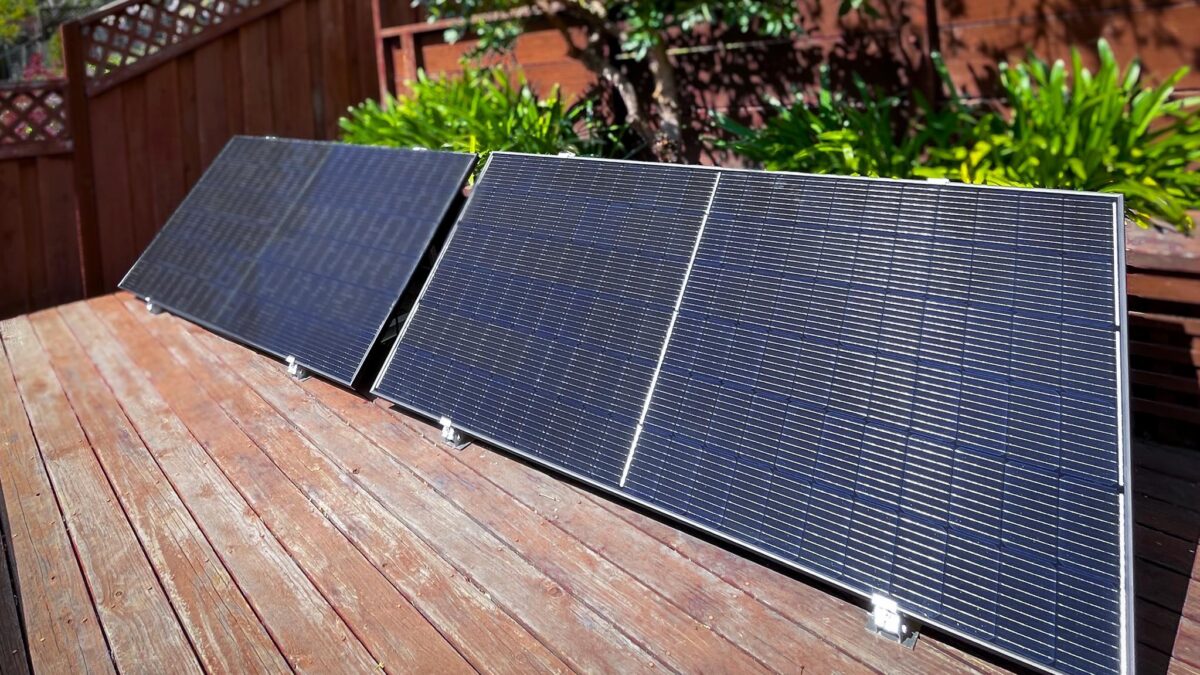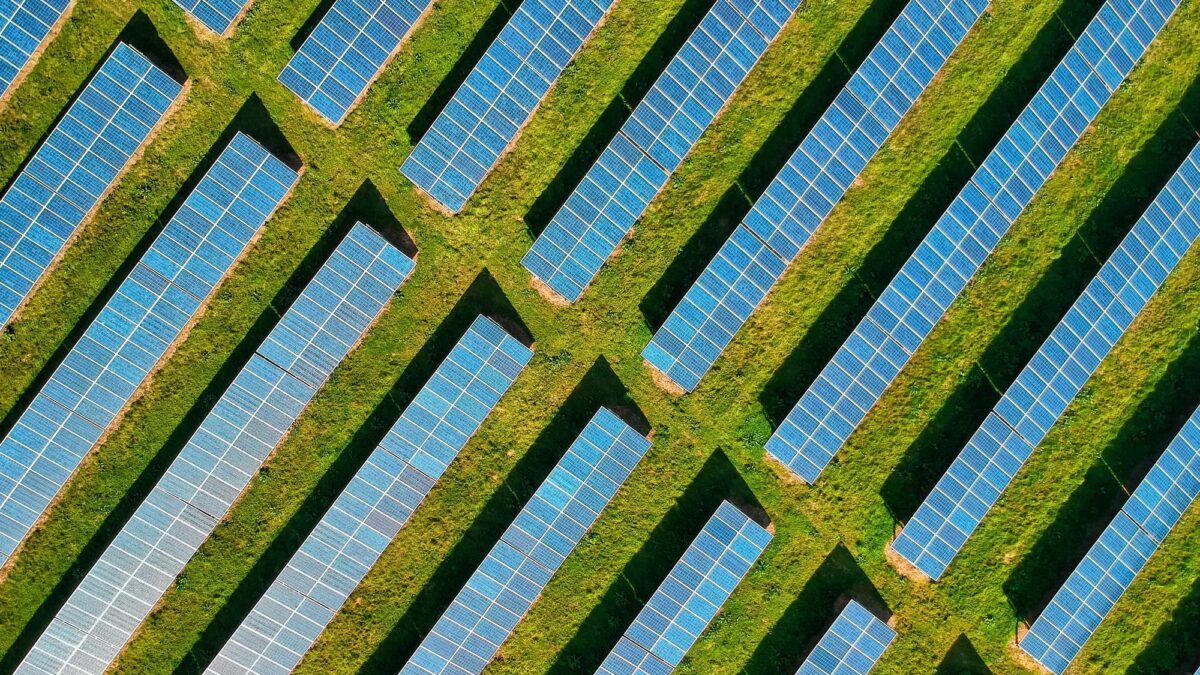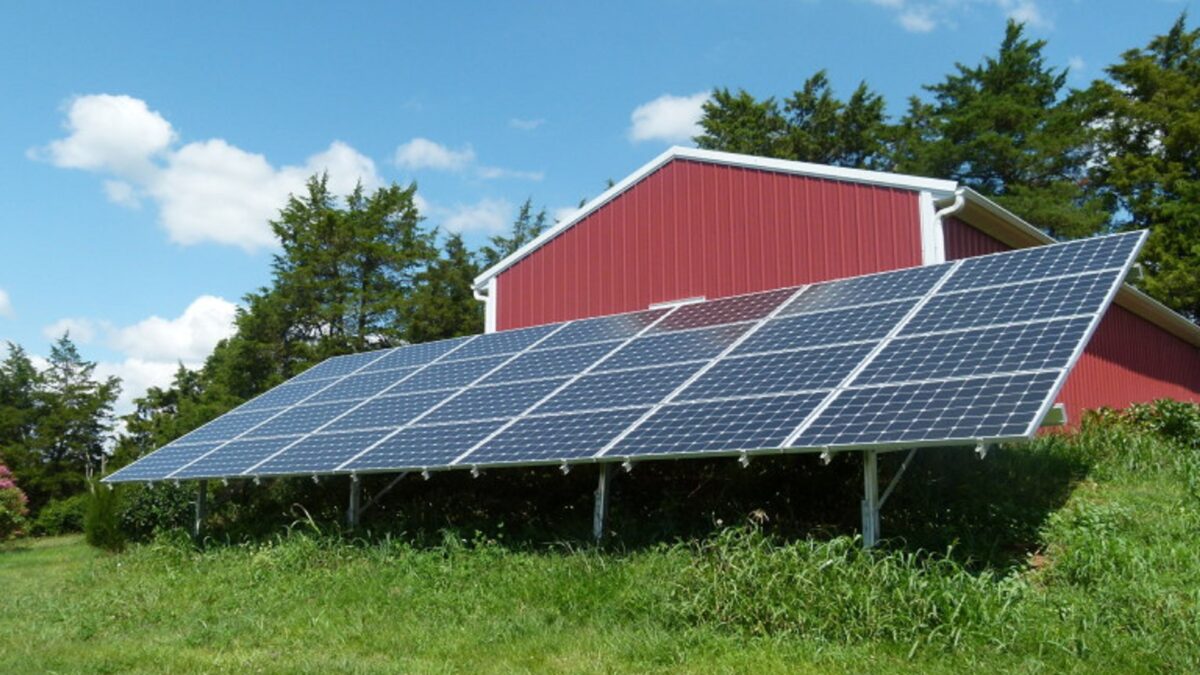The Ultimate Solar Co-op Guide
- Guide
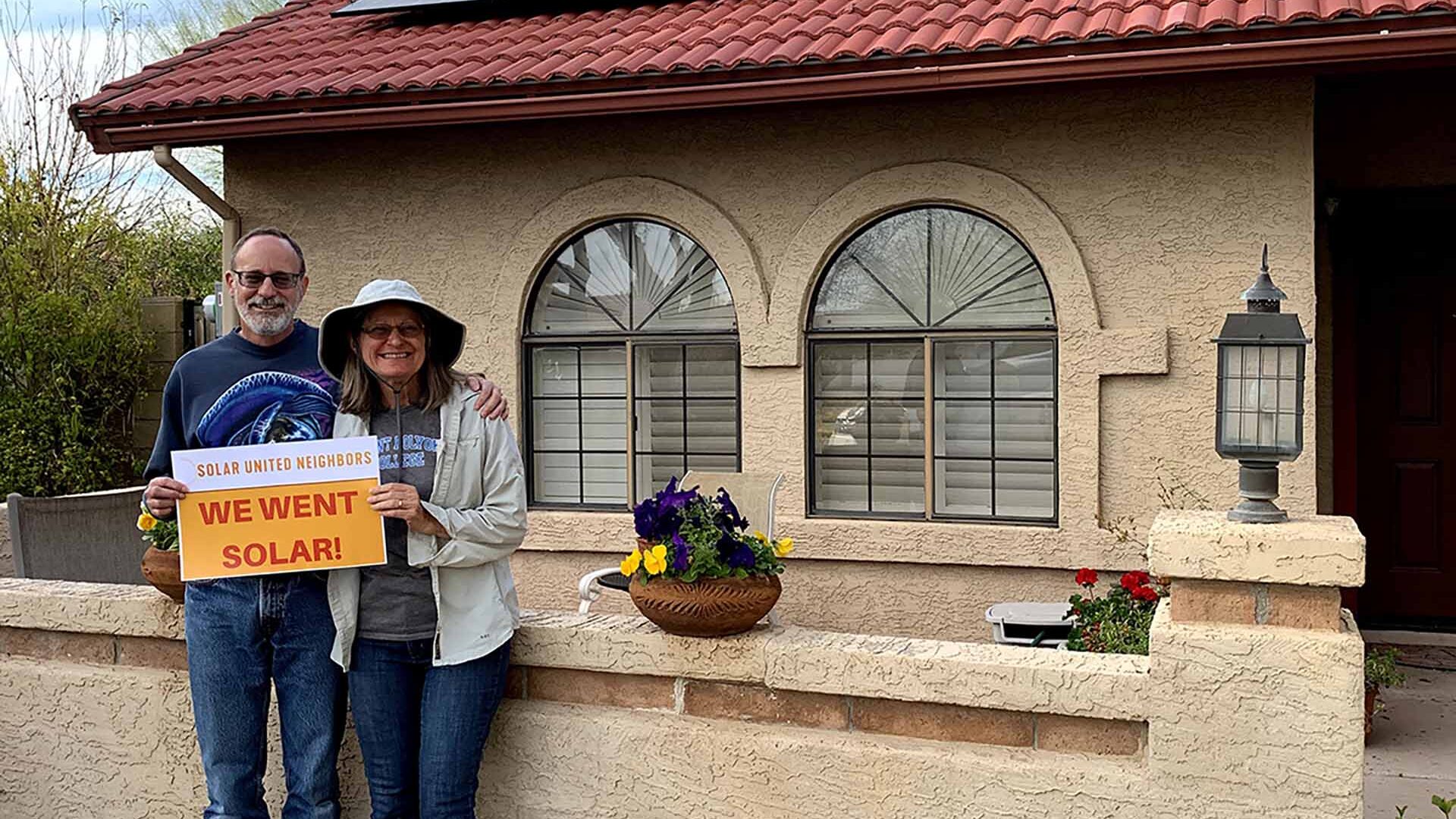
Want to learn more about solar co-ops? And how they can help you go solar? You’re in the right place!
We’re glad you found us. And we’re proud to serve as a resource as you consider taking your home or business solar. In this Guide, you’ll find everything you need to know about solar co-ops.
Going solar is a rewarding decision to make, regardless of your reasons — and a solar co-op demystifies the process and ensures you get top quality, both in pricing and installation.
What is a solar co-op?
What is a solar co-op?
A solar co-op is a group of property owners who use their combined buying power to save money going solar. We’ve helped thousands of people go solar in hundreds of co-ops across the country. If we don’t have an active program in your area, we can also help you go solar on your own.
Solar co-ops are member driven and free to join. You are never charged by Solar United Neighbors for participating in a solar co-op. As a solar co-op member, you will receive a personalized bid from a solar installer selected by the group. At that time, you can decide whether to move forward with your solar installation.
Solar co-op benefits
Competitive pricing
Buying solar as part of a group saves you money. Co-ops solicit competitive bids from installers, so you’ll get a great price on a personalized solar proposal. For installers, finding and acquiring solar customers is a major expense. Servicing our solar co-op members is less expensive for installers, meaning they can charge you less.
Co-op support
Solar co-ops offer support and peace of mind. Our team of solar professionals provides expert, independent advice to you throughout the process. We’re here to make sure you are armed with all the information you need to make informed decisions about your solar investment. Since we’re a non-profit – not an installer – our primary interest is making sure you have a great experience going solar.
How a solar co-op works
Solar co-ops are free to join, and joining does not commit you to going solar. Solar co-op regions may be county-wide or even span multiple counties; members of the solar co-op do not necessarily live right next to each other. The process can take anywhere from three to nine months, depending on when you join the co-op. Most of our co-ops have between 30-100 members. They’re big enough to attract competitive bids from installers, but small enough to meet and connect with other members.
Learn about the co-op
A new solar co-op starts with a series of free, public information sessions. Our experts explain the basics of solar technology, solar economics, and how our co-ops work. These information sessions are tailored to your area, since local policies and incentives can have a big impact on your experience going solar.
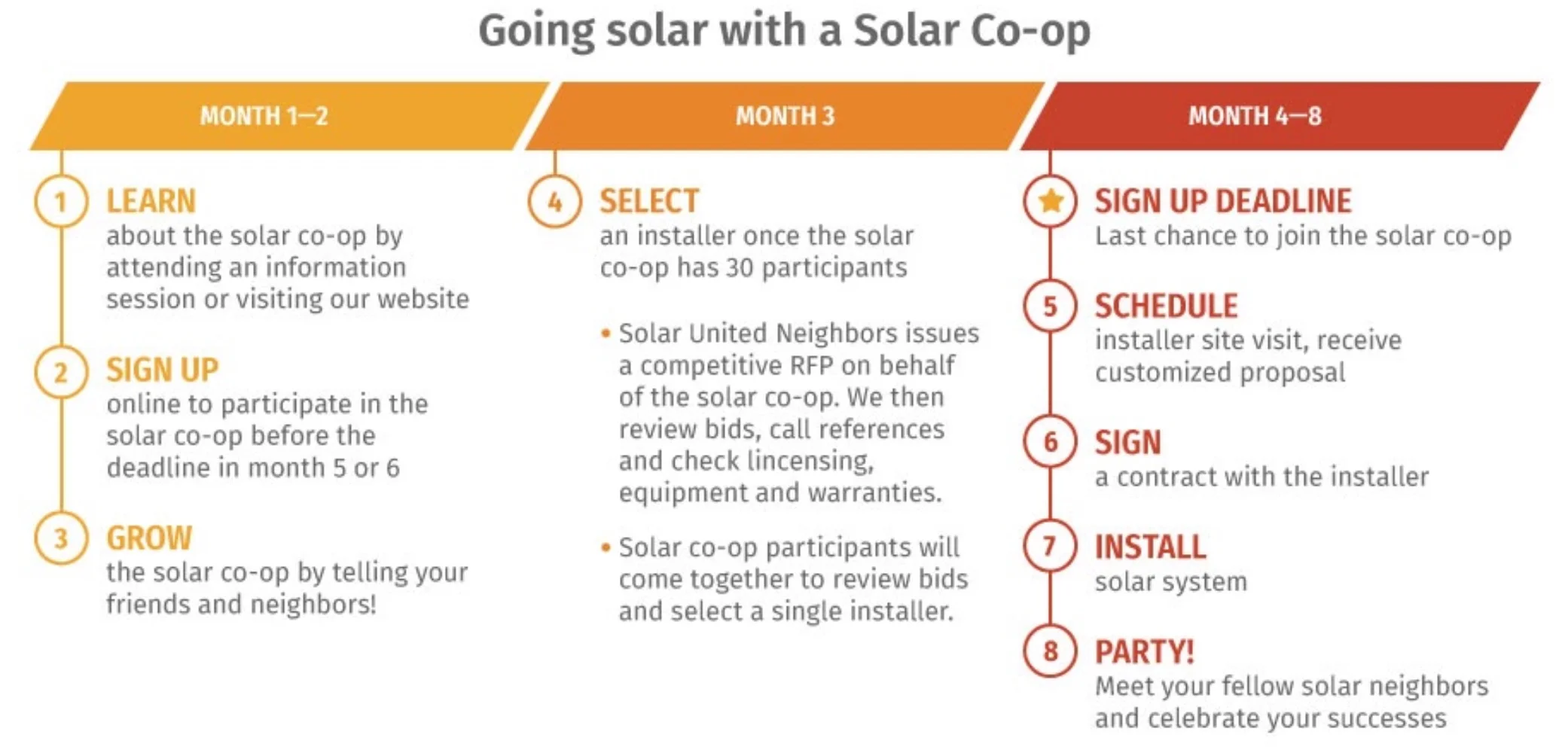
Joining the co-op
Joining your local solar co-op is free and does not commit you to going solar. We help you evaluate your property (typically the roof) for solar, and show you how going solar can add up to big energy savings.
Selecting an installer
Once there is a critical mass of solar co-op members (usually 20 to 30), Solar United Neighbors issues a request for proposals to local solar installation companies on behalf of the co-op. Co-op members volunteer to serve on an Installer Selection Committee that meets to review the submitted bids and selects one solar installer to service everyone in the solar co-op. Our team is present during the selection committee meeting to facilitate and provide technical expertise, but you and your fellow solar co-op members select the installer that best fits the local group’s needs and priorities.
Time to go solar
Additional members can still join the solar co-op for a limited period of time after an installer is selected. The installer will work with each co-op member to develop a personalized proposal, at which point you can choose whether to sign an installation contract.
How solar co-ops are funded
We do not charge members a fee to join a solar co-op. The selected installer pays a referral fee to Solar United Neighbors for each co-op member who signs a contract for solar. We use these funds to develop future co-ops. Since solar co-op members are educated about solar and their roofs have already been evaluated, our process saves the installer significant time and money acquiring and educating potential customers, ultimately saving you money as a consumer.
Solar financing
Solar financing
How can I finance my solar installation?
From the first day you turn on your solar system, your energy bills will go down. How much money you save and how quickly depends on a few factors: how your system is financed, and how you are credited for the energy your solar panels generate.
Direct solar ownership
Many solar owners choose to pay for their systems outright or with a personal or business loan. Loans are available up to 20 years in length. Most are unsecured (meaning they don’t require collateral) and rarely have penalties for early repayment. The savings you generate on your electricity bill from solar may equal or exceed the amount you are paying on your loan. So, even with a loan, you could be saving money from day one.
The most attractive loan is often a home equity line of credit (HELOC). These leverage the value of your home to improve it with the installation of a renewable energy system. Even with recent changes to the federal tax code, interest on HELOC loans used to buy, build, or improve the borrower’s home can be tax deductible.
Benefits of direct ownership
With direct ownership, you can claim state tax credits and other incentives for solar, and you retain the rights to any solar renewable energy certificates (SRECs) your system generates. If you live in a state with an SREC market, this can be a significant source of additional revenue from your solar installation.
(Our advice here is for informational purposes only. Consult your accountant and/or a tax attorney to determine how to properly take advantage of solar tax credits.)
Third-party solar ownership
In some states, property owners can purchase the electricity produced by a solar array without owning the system itself. In those states, you can use renewable energy and save money, while avoiding the up-front expense of installing and owning a solar array outright. Solar panels are installed on your home, but they are owned by the installer, who is responsible for system performance and maintenance. As a customer, you take advantage of cheaper electricity costs provided by solar.
There are two main types of third-party solar ownership: Under a power purchase agreement (PPA), the customer agrees to purchase the power generated by the panels, while under a solar lease, the customer pays a fixed, monthly fee.
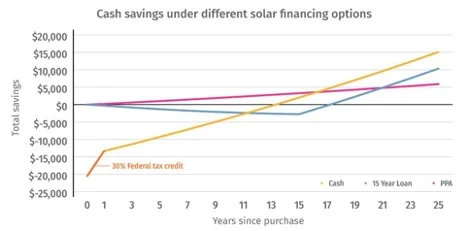
What about the rest of my energy bill?
With a PPA or lease, you will generally have two electric bills: one from your solar company for the electricity produced by the panels, and one from your utility company for any electricity you consume from the grid when your panels don’t produce enough electricity to cover your needs.
Unfortunately, not every state allows third-party ownership. One of our priorities at Solar United Neighbors is to change that.
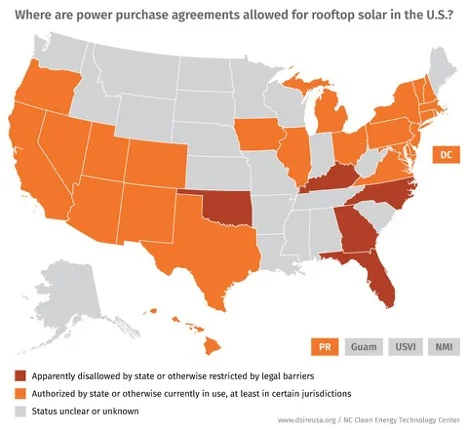
Related solar financing resources
Incentives for rooftop solar
Incentives for rooftop solar
What incentives are available for rooftop solar?
Federal and local incentives can have a big impact on the cost of going solar. Below, we cover a few of the most commonly available incentives.In some cases, you may qualify for additional financing options, grants, or rebates based on local and state policies.
Federal solar investment tax credit (ITC)
First passed in 2006, the ITC was the most impactful solar policy in U.S. history. It led to an average of 54% annual growth in solar since it was enacted. It was designed to lower the cost of solar and jumpstart the solar industry. And it worked. Members of Congress from both major political parties voted for the ITC, and it was signed into law by President George W. Bush.
In July 2025, Congress voted to repeal tax credits for solar. Click here to contact your members of Congress and share your support for solar energy.
The residential solar tax credit expired at the end of 2025. If buying a system outright or through loan financing, homeowners will no longer be able to qualify for the credit. However, third party ownership models (solar leases and power purchase agreements) qualify under the commercial tax credit. This is still in effect through 2029. In these cases, the system owner would be eligible for the federal tax credit as long as certain requirements are met. Your solar installer will be able to let you know if your system qualifies.
State and local solar incentives
Some locations offer state- or county-level incentives to residents who want to install solar. These may be cash grants, reduced permitting fees, or specialized assistance to low-income homeowners. A small number of utilities offer incentives for solar customers. You can learn more about solar incentives and unique financing options on our state pages.
Net metering
Net metering
What is net metering?
At any given time, you may not be able to use all the electricity your solar panels generate. When your solar array is producing more power than you need, the excess power flows out through your electric meter and is used by nearby homes or other buildings. When your panels are producing less power than you need, or there isn’t enough sunlight to meet your consumption needs (e.g. at night), your house automatically draws additional energy from the electric grid.
Net metering is the policy that allows you to receive credit for the extra electricity your solar panels generate. The “net” energy that you’ve used at the end of your billing period (electricity used minus electricity generated) is what determines your final monthly electricity bill.
Net metering policies
Some net metering policies are better than others. We believe utilities should value the electricity you generate at the same rate as the energy you purchase. However, some state laws allow utilities to compensate solar owners at lower rates and/or tack on additional service fees and charges. A bad net metering policy can significantly extend the time it takes to pay back your solar system.
Fighting for fair net metering policies for solar owners is one of our most important priorities at Solar United Neighbors.
What happens if I generate more power than I use?
It depends on your state or utility net metering policy. In most cases, if your solar array has generated more electricity than your home has used within a single billing period, the excess rolls over onto your next electric bill. It’s like ‘rollover minutes’ for your cell phone.
How rooftop solar and net metering benefit the electricity grid
Rooftop solar energy has been shown to be a net positive for the electric grid and non-solar consumers as well as for solar owners. Locally produced solar energy avoids the high costs of transmitting electricity over long distances from centrally located power plants. This has been confirmed by numerous independent studies, many of which observe that solar provides energy during times of peak demand, when that power is most valuable.
Is net metering a subsidy?
No. Unfortunately, we hear this argument a lot. Net metering is about fairly compensating solar generators for the energy they create. It protects your right as a property owner to self-generate your own energy. Numerous independent studies by third parties and state utility commissions prove the benefits of net metering extend far beyond solar customers and far outweigh the minimal direct cost to utilities.
Solar Renewable Energy Credits (SRECs)
Solar Renewable Energy Credits (SRECs)
What is a Solar Renewable Energy Credit (SREC)?
In some parts of the U.S., owners of renewable energy generation facilities can be compensated above and beyond the value of the electricity they generate. These owners receive renewable energy credits (RECs), which represent the environmental, social, and other values of renewable energy generation. RECs may be bought or sold separately from the electricity that created them.
A solar renewable energy credit (SREC) is created when a solar energy system produces 1,000 kilowatt-hours (kWh) of electricity. An SREC may be “owned” by a utility, a customer, or a solar provider. SRECs fluctuate in value depending on supply and demand in the SREC market, which may be driven by consumer demand or by policies establishing renewable energy targets. SREC markets vary widely by state and utility district. A healthy market for SRECs can significantly speed up your solar payback period.
Where are SREC markets?
Solar owners can sell their SRECs anywhere within the PJM territory. PJM is the company that manages the electric grid for all or part of 13 states and the District of Columbia. (Source: PJM)
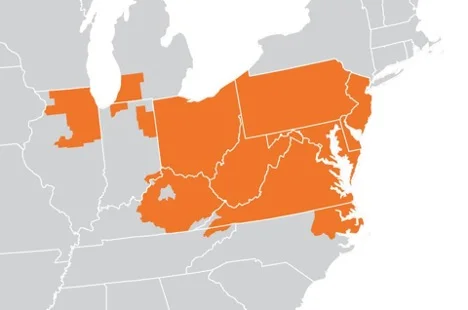
How SRECs make you money
SRECs are bought and sold on an open market, and prices are determined by supply and demand. The more SRECs that are supplied to the market from solar projects, the lower their price. The higher the target for solar energy in a state, the higher the price of SRECs. Laws requiring renewable energy generation are called renewable portfolio standards (RPS). Instead of producing renewable energy themselves, utilities can choose to purchase SRECs on the open market.
What is a renewable portfolio standard (RPS)?
This policy, also sometimes called a renewable energy standard (RES), requires a specific percentage of the electricity generated in a state to come from renewable sources. Utilities must either generate it themselves or purchase RECs in order to meet their renewable energy generation targets. The more aggressive your state’s RPS, the higher the REC prices, and the more quickly you can pay back your solar installation.
Similar to net metering policies, RPS policies can be strong or weak, depending on the percentage target, how quickly it increases, and what types of energy qualify as “renewable”. Another factor impacting REC pricing is the alternative compliance payment (ACP) that utilities must pay if they miss their target. RPS policies that include a specific target for solar energy are most effective at creating high SREC prices.
How your solar system creates SRECs
Once it has been certified and registered (your installer will help you with this), your solar system will produce one SREC every time it produces a megawatt-hour (1,000 kWh) of electricity. The best way to estimate your annual solar energy production is by using a tool like PVWatts, which takes into account your location, system size, and other factors.
How to sell SRECs
SREC brokers help you sell your SRECs on a local or regional market. Most will offer different options with different levels of risk and reward, similar to selling stocks. Options may include:
Upfront payment
Sell the rights to all of your system’s SRECs upfront for a cash payment.
Annuity
Sell your SRECs under a contract for a set period of time — usually three, five, or ten years — for a guaranteed price.
Spot market
Authorize your SREC broker to sell your SRECs immediately when the credits are generated.
Discounted SREC pricing for Solar United Neighbors members
Solar United Neighbors offers discounted SREC pricing for our co-op members and our annual and lifetime members. Please see our SRECs page for more details.
Solar energy technology
Solar energy technology
How does solar energy work?
Modern solar photovoltaic (PV) systems have two important parts: a collection of solar panels, called an array, and one or more inverters. Your solar array generates electricity from sunlight, and the inverter(s) make the electricity usable in your home. In addition to the array and inverter(s), there are also connecting cables, racking, and other minor parts referred to as the balance-of-system (BoS) components.
Solar PV vs. solar thermal
Solar PV systems directly generate electricity from sunlight without using heat. Solar thermal systems capture heat energy, generally to heat water. They do not rely on electrical currents. Solar thermal systems are sometimes called “solar hot water”. Some homes have both types of solar, but they are different technologies. Our solar co-ops focus exclusively on solar PV.
What is a solar array?
A group of solar panels wired together on a rooftop (or on the ground) is called a solar array. Individual solar panels are made of PV cells. These cells are made of refined semiconductors, typically silicon, that convert light energy from the sun into electricity. When light hits a solar cell, it generates a type of electricity called direct current (DC).
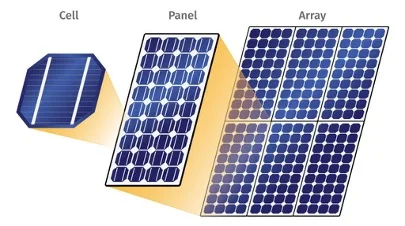
DC electricity isn’t compatible with most American homes and appliances, which run on alternating current (AC). Your solar installation will include one or more pieces of equipment called inverters, which convert the DC electricity from your panels into AC electricity that your home can use.
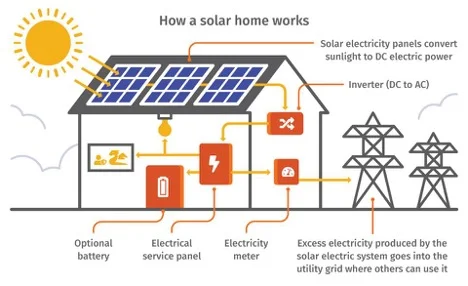
Most solar homes remain connected (tied) to the electricity grid, seamlessly transitioning between consuming on-site solar electricity during the day to drawing electricity from the utility grid at night.
What happens when the power goes out?
During a power outage, active grid-connected solar panels can be dangerous for utility line workers. Your solar array will automatically shut off to prevent back-feeding electricity into utility lines that are being repaired. You will need a home battery backup system in order to power your home when the grid is offline.
What is a solar inverter?
Inverters convert the direct current (DC) electricity produced by your solar array into alternating current (AC) electricity that you can use to power your home. Inverters are the second-most important – and second-most expensive – part of your solar installation, after the panels themselves.
The simplest type of inverter is a central or “string” inverter, which is installed near your home’s electric panel. Central inverters convert all the energy from your solar array into AC electricity at a single point, effectively treating your array as one large unit. Central inverters operate most efficiently if none of your panels are shaded by nearby buildings or trees; if even a few panels receive shading, reduced efficiency may result.
Another option is a set of microinverters, which attach to the panels directly and optimize the electricity generation of each individual panel. This means that if one or more panels receive shading, the energy output of the other panels won’t be affected. Microinverters can be more expensive to install but have the added benefit of monitoring how much energy each individual panel produces.
How long do inverters last?
Central inverters are typically warrantied for 10-12 years; microinverters for 25 years. By comparison, your solar panels will typically last 25 years or more without significant performance degradation. Your installer will recommend an inverter configuration that best meets the needs of your custom installation.
Batteries and solar energy
Batteries and solar energy
How do batteries work with solar energy?
If you rely on electricity to power life-sustaining medical devices or live in a home with an electric water pump, a power outage can have serious consequences. On-site solar energy provides part of the solution, but in order to keep the power on during an outage, you’ll also need batteries.
As prices fall, more and more prospective and current solar owners are considering installing batteries with their solar systems. Some of our solar co-ops offer an option to add battery storage (as well as electric vehicle charging). Some solar owners opt to install batteries to provide power during grid outages, for life-sustaining medical devices, or for other reasons.
What should you think about when considering solar + storage?
Battery storage systems can take up room in your home, can require maintenance, and will likely need to be replaced during the life of your solar system. Many battery storage systems also require additional equipment, wiring, and configuration when being integrated into a solar system. Pairing solar and storage will keep your batteries charged and ready for use when the power goes out. If you might want batteries in the future, be sure to tell your solar installer during their evaluation of your property.
Batteries will increase the cost of your solar system. Their value is in reliability and peace of mind, not in saving money.
How much of your home can you power with batteries?
Battery storage systems are modular, so you can power as much of your home as you can afford. However, due to their high upfront cost and lack of economic incentives, most battery storage systems are designed to power only critical functions during a grid outage.
Installers size each battery system to meet the needs and preferences of individual customers. This process involves determining which appliances are most important for you to keep running during an outage, how much electricity you want to store, and for how long you would like to store it. Your installer will help you select the appropriate size and type of battery storage system to meet your needs.
How much do batteries cost?
The cost of batteries depends on how much backup power you need, and for how long. Those factors determine what hardware you’ll need, and what the installation and maintenance costs will be.
At 2019 prices, you can expect the addition of batteries to your home to cost between $6,000 and $20,000.
Want to really dig into battery storage?
Download our free Battery Storage Guide today.
Ready to go solar in a co-op?
Get the latest on solar straight to your inbox.
Fight for your solar rights.
Everyone has the right to go solar. Spread the sunshine nationwide and in your local community by taking action, joining events, and more.
